On This Page
Why Purple Martins Need Birdhouses
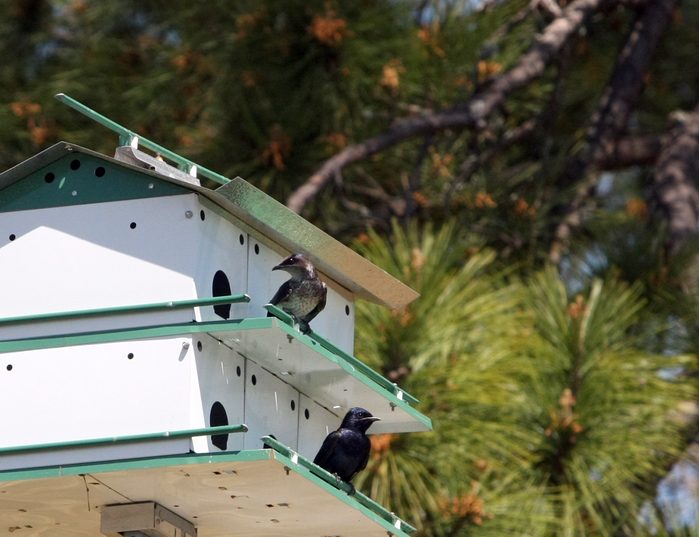
Historically, purple martins nested in natural tree hollows, old woodpecker holes, and cliff crevices near water throughout most of the U.S. The birds continue to do so in the West, especially in saguaro cacti. But in the eastern half of the country, purple martins now nest almost exclusively in manmade boxes. Native Americans began the tradition thousands of years ago when they found that a hollow gourd placed in a tree was attractive to breeding bird pairs. Man-made purple martin houses are now essential to martins’ survival.
An estimated 1 million purple martin landlords listen each spring for the chortling call of their summer tenants reappearing from the south. Martins can often be heard calling as they glide above forested areas in an attempt to attract younger adults to the colony. In summer, purple martin houses across the country are filled with adults ready to raise their young.
Learn to identify 8 types of swallows.
How to Choose a Purple Martin House
“I’m new to attracting purple martins. Can you give me some guidance on choosing and setting up a birdhouse?” asks Birds & Blooms reader Cindy Phelps of Louisburg, North Carolina.
Birding experts Kenn and Kimberly write, “The abundance of choices for purple martins can be daunting. To get started, we recommend a house made of aluminum (painted white to reflect heat) or very thick white plastic, with at least 12 compartments. Wooden houses work, but they’re heavy, which is a drawback as the house should be mounted 12 to 18 feet above the ground. You need to be able to open each compartment individually for cleaning. For mounting, it’s best to have a sturdy pole with a pulley system so that the house can be easily raised and lowered.”
Each individual apartment should measure at least 6 x 6 x 6 inches. The entrance hole should measure 2 1/8 inches. The Purple Martin Conservation Association offers a wealth of information on attracting these birds.
Here’s how to grow birdhouse gourds and make a DIY purple martin gourd house.
Where to Place a Purple Martin House
Purple martins are colony nesters, which means they nest in groups. Whether you choose gourds or an apartment-style model, place your purple martin houses in an open area that is 40 to 60 feet away from trees and at least 12 to 18 feet above the ground. Purple martins are one of the only birds that will tolerate swaying birdhouses.
“We put up a purple martin house last year, but had no takers. Is there anything we can do to help martins find it?” asks reader Judy Roberts of Graytown, Ohio.
Kenn and Kimberly say, “Purple martins are choosy, and attracting them to a new house can take time. Make sure the house is in an open area, not hemmed in by trees. Keep the entrance holes sealed during winter so house sparrows and starlings won’t move in. Open them only around the time when the martins are expected to return in spring. Keep the house up through late summer, even if it hasn’t attracted tenants yet. Young martins look in late summer to find sites for the next year.”
Discover fascinating barn swallow facts.
Be a Good Purple Martin Landlord
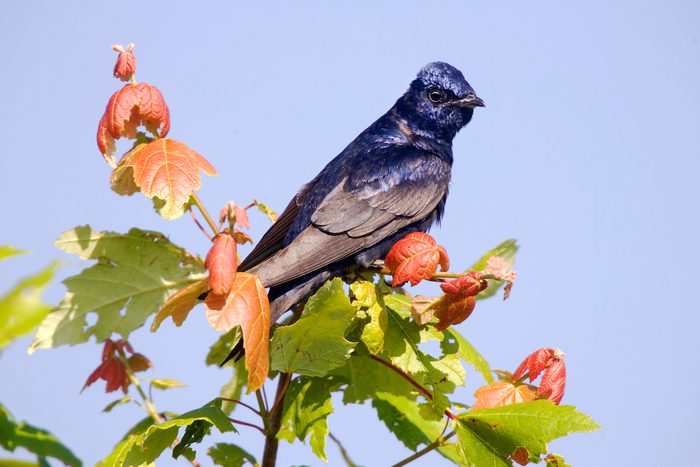
Just like monitoring bluebird houses, being a purple martin landlord takes time and commitment. In summer, boxes must be kept free of non-native house sparrows. In late fall, boxes must be cleaned and closed. But it’s all worth the effort. Hosting purple martins means you’ll get to enjoy these feathered good neighbors during spring and summer before they fly the coop in fall.
Do purple martins eat mosquitoes? Here’s what you should know.
Inside a purple martin house, the nest is a cup of grass, leaves, twigs, miscellaneous debris and usually some mud. Learn more about swallows nests and nesting habits.
“Purple martin houses are a hub of activity. It’s fascinating to watch purple martins come and go. I love to watch for the youngsters poking their heads out of the boxes,” says naturalist and nature writer Ken Keffer.
Next, learn how to identify and attract a tree swallow.
Why Trust Us
For nearly 30 years, Birds & Blooms, a Trusted Media Brand, has been inspiring readers to have a lifelong love of birding, gardening and nature. We are the #1 bird and garden magazine in North America and a trusted online resource for over 15 million outdoor enthusiasts annually. Our library of thousands of informative articles and how-tos has been written by trusted journalists and fact-checked by bird and garden experts for accuracy. In addition to our staff of experienced gardeners and bird-watchers, we hire individuals who have years of education and hands-on experience with birding, bird feeding, gardening, butterflies, bugs and more. Learn more about Birds & Blooms, our field editor program, and our submission guidelines.
Sources
- purplemartin.org, the website of the Purple Martin Conservation Association
- Kenn and Kimberly Kaufman, official birding experts for Birds & Blooms
- Ken Keffer, naturalist and author
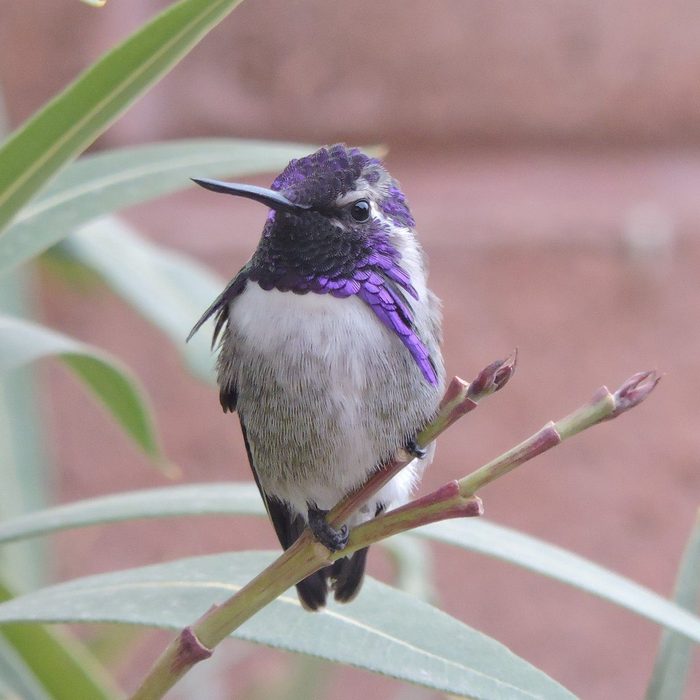
Hummingbirds are tiny marvels of nature, fascinating us every time they flutter by. Chalk it up to the speed at which their long, thin tongues draw nectar from flowers (up to 13 times per second) or to their ability to use their sturdy tail feathers to make hairpin turns. Still, one of the most interesting aspects of hummingbirds is not apparent to the naked eye. In fact, it was realized only in the last few years. A recent study published by the National Academy of Sciences called “Wild Hummingbirds Discriminate Nonspectral Colors” suggests that hummingbird eyes see the world in a range of brilliant colors, of which humans can only dream.
On This Page
Science of Hummingbird Eyes
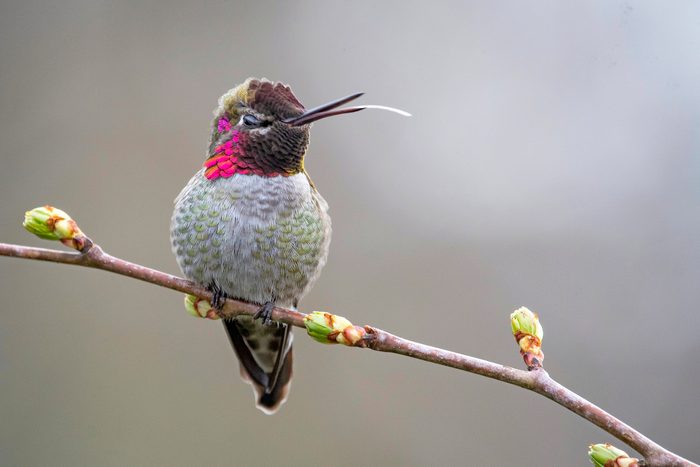
A hummingbird’s relatively large eyes are wired to pick up many more hues than human eyes can see. Hummingbird retinas possess four types of cones, while humans have only three that detect blue, green and red tones. The fourth type of cone that hummingbird eyes have is sensitive to ultraviolet light, which people cannot see. And when the ultraviolet hues blend with ones that humans can perceive, new colors appear.
Of all the colors in the rainbow, hummingbirds love the color red, and for a very good reason: Their retinas have a more dense concentration of cones, which mutes cooler shades like blue and heightens warmer shades like red and yellow. It’s fascinating how a small creature can have such intricate anatomy.
How Hummingbirds Use Their Keen Eyesight
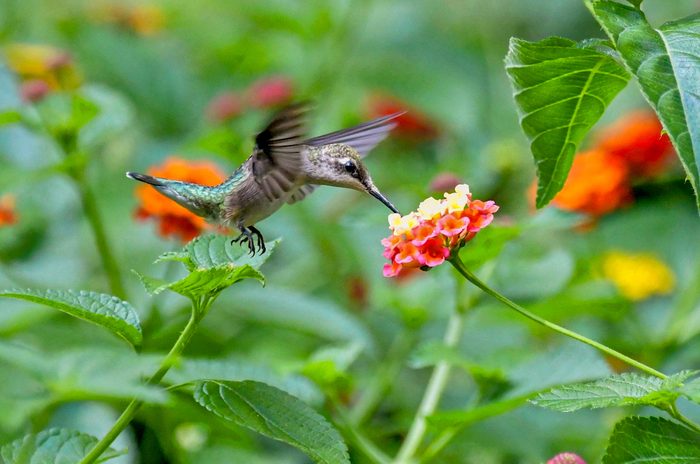
Having expansive vision helps hummers do a variety of tasks, including finding mates and spotting food sources. And this is especially true when it comes to locating flowers that hold their life-sustaining nectar.
If you’re looking to attract hummingbirds to your yard, plant colorful flowers like phlox, hollyhock, foxglove and lantana. Remember, hummingbirds love the color red, so the more red you can get blooming, the faster a few new friends may be drawn in.
The next time you see a jeweled wonder fly by, take a moment to not only to welcome the visitor with an array of appealing nectar sources but to appreciate and imagine the spectacular colors that it recognizes out in nature.
What makes hummingbird feathers so shimmery?
Field Test
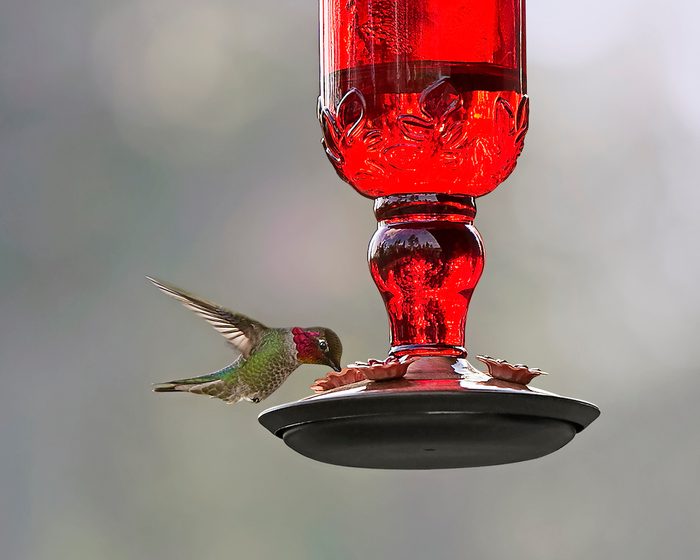
Here’s how the researchers proved their ultraviolet theory.
The scientists performed outdoor experiments with wild hummingbirds to test how well they see different ultraviolet colors. They engineered special LED tubes that emitted several colors, both on the visible and ultraviolet (UV) spectrum. They placed the LED tubes next to two feeders. The one with plain water did not give off ultraviolet rays and another with sugar water did give off UV light.
They trained hummingbirds to associate the UV light with the reward of sugar water and regular light with plain water. When scientists rearranged the placement of the feeders, similar to the Pavlovian dog experiment, the hummingbirds were still more quickly drawn to the feeder giving off ultraviolet light—which proved that the birds could tell the difference between the one emitting the special rays and the normal feeder.
The hummingbird heart rate is unbelievably fast.
Do Your Own Experiments
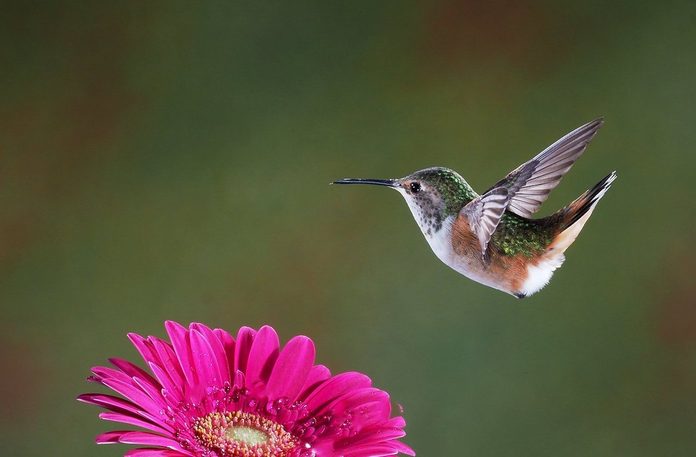
Citizen science projects such as eBird, Backyard Bird Count and NestWatch are looking for birders and gardeners to provide valuable data for researchers. Visit their websites to look up opportunities and see how you can lend a scientific helping hand.
How fast do hummingbirds fly and flap their wings?
- Additional reporting by Kelly Aiglon
- Reviewed by birding experts Kenn and Kimberly Kaufman
Why Trust Us
For nearly 30 years, Birds & Blooms, a Trusted Media Brand, has been inspiring readers to have a lifelong love of birding, gardening and nature. We are the #1 bird and garden magazine in North America and a trusted online resource for over 15 million outdoor enthusiasts annually. Our library of thousands of informative articles and how-tos has been written by trusted journalists and fact-checked by bird and garden experts for accuracy. In addition to our staff of experienced gardeners and bird-watchers, we hire individuals who have years of education and hands-on experience with birding, bird feeding, gardening, butterflies, bugs and more. Learn more about Birds & Blooms, our field editor program, and our submission guidelines.
Sources
- National Academy of Sciences of the United States
- National Geographic
On This Page
Why You Should Add Nicotiana to the Garden
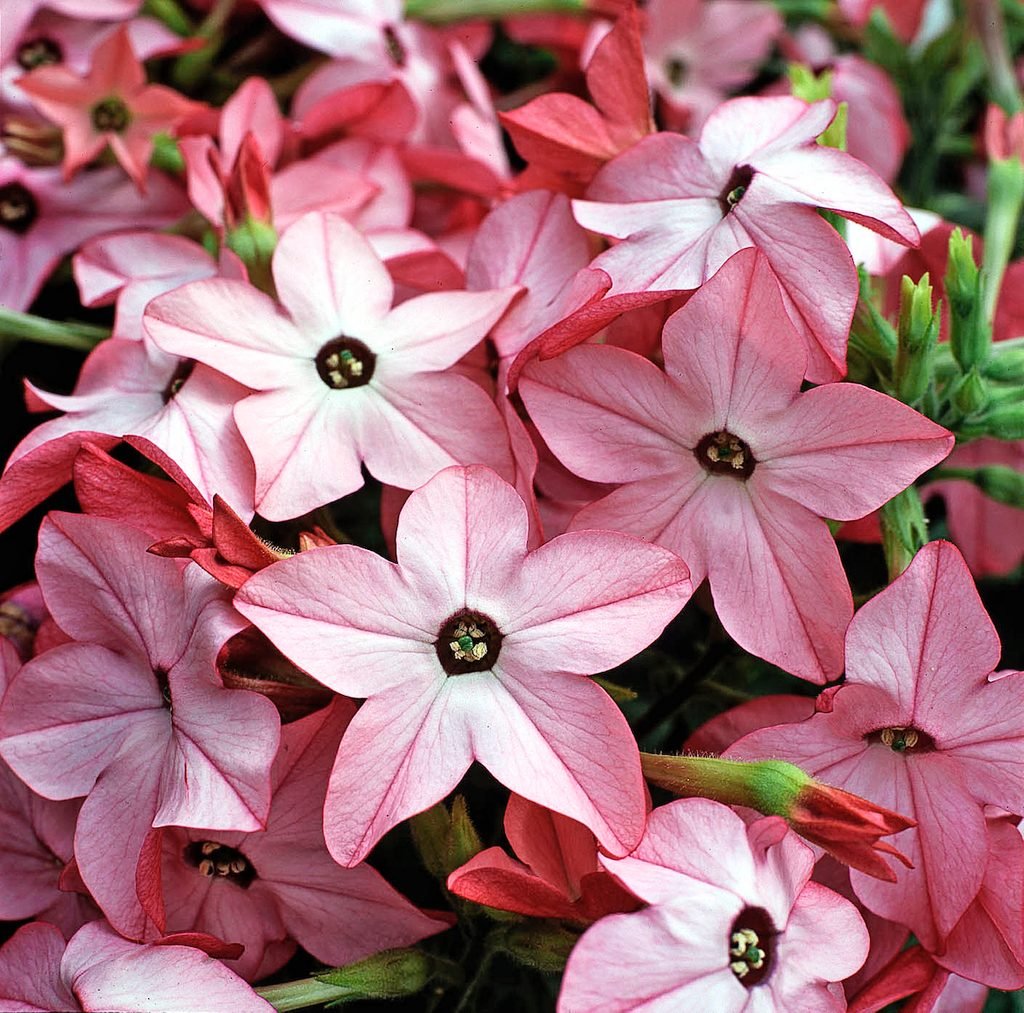
If you want to create an inviting space for hummingbirds to visit in your yard, nicotiana will entice them with tube-shaped flowers and plentiful nectar. This cottage garden favorite, also known as flowering tobacco, is an easygoing plant that will provide color and fragrance all summer long.
Barbara Pierson, horticulturist and nursery manager of White Flower Farm in Litchfield, Connecticut, says, “We love growing nicotiana in the garden because they are practically carefree. No fussy watering or soil requirements and the free branching habit requires no staking. They like a sunny spot, but I have found that part shade can work, and the flowers tend to hold better with a little shade.”
Nicotiana Care and Growing Tips

- Scientific name: Nicotiana spp.
- Common name: Flowering tobacco
- Zones: 10 to 11 or annual
- Light needs: Full sun to partial sun
- Size: 1 to 5 feet tall
These plants like to be in well-drained soil and full to partial sun. You can start seeds indoors several weeks before the last frost date or look for plants at your favorite garden center.
Nicotiana is hardy in USDA plant zones 10 and 11, or treat it as an annual. If you don’t remove spent flowers, you may get a few volunteer seedlings next year.
‘Towards the end of the growing season here in Connecticut, we allow them to produce as much seed as possible so that we have seedlings the following summer,” says Barbara. “Plants that self sow are welcome surprises in spring!”
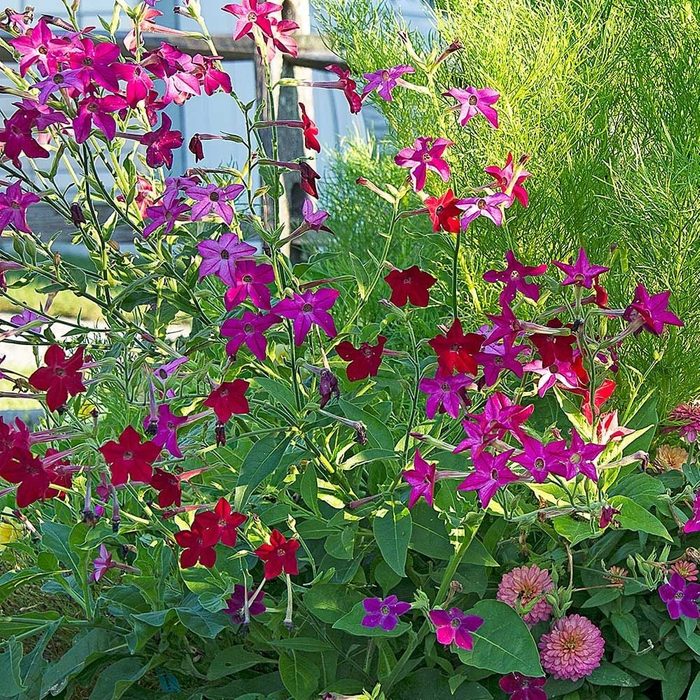
To keep the plants looking their best, keep up with watering during hot weather. This is especially important for container-grown plants, which dry out faster.
“Keeping your plants healthy by watering when needed will ensure flower production and hummingbird visits through the summer. Nicotiana will wilt slightly, so knowing when to water can be done by observing the plants during hot sunny stretches of weather,” says Barbara.
Where to Plant Nicotiana

“Nicotiana comes in a variety of sizes,” says Jen McGuinness, author of Bird-Friendly Gardening: Guidance and Projects for Supporting Birds in Your Landscape.” Tall varieties can be incorporated into the back of the garden, while the smaller, more compact plants can be grouped together in the front of a border or used in container plantings. Consider planting nicotiana with other flowers that attract hummingbirds, such as wild bergamot (Monarda fistulosa) and butterfly weed (Asclepias tuberosa).”
Barbara suggests using nicotiana both in the garden and in pots. “The large stature (taller) varieties are best grown in the garden. They can be grown in pots if the container is large enough. The shorter varieties can be grown in the garden or in pots on a patio. If you choose to grow them in pots to attract hummingbirds to your deck, remember that they do take more water when pot grown. I have done this successfully at home and love watching the hummingbirds visiting the tubular flowers.”
Fragrant Floral Scent
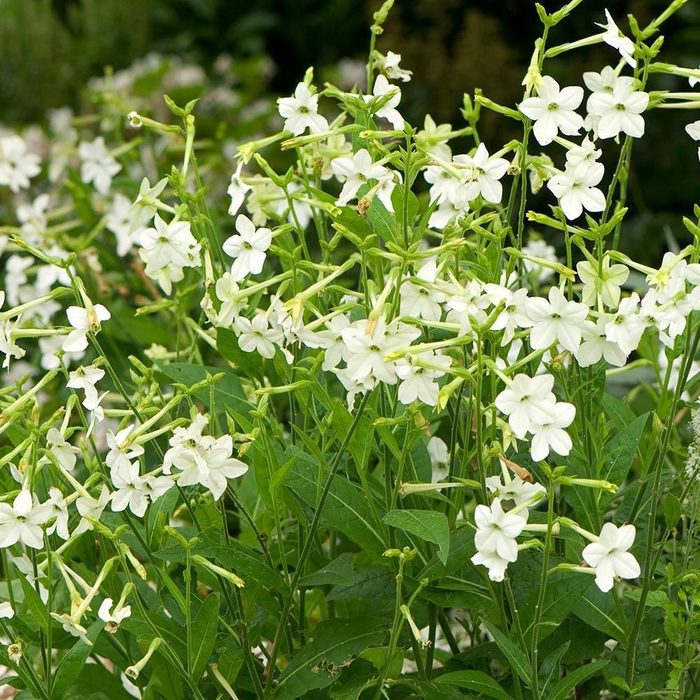
In addition to adding graceful structure to plantings, nicotiana offers a lovely scent that carries through the yard and garden. The tubular-shaped flowers appear on branched stems during summer to provide color and fragrance all season long and into fall.
Nicotiana is known for a perfume fragrance that starts to linger at dusk and into the evening. The flowers smell sweetest after dark. For an intoxicating scent, try Nicotiana alata. The white flowers will illuminate a moon garden.
Best Nicotiana Varieties

Nicotiana blooms can be found in a range of colors, including white, rose, lime green and purple. Barbara suggests using ‘Perfume Deep Purple,’ an All-America Selections winner that can be grown in the ground, raised beds or pots. “I love the dark purple color with older flowers fading to lavender and fragrance of this variety. It can also be grown in part shade.”
Nicotiana alata is a popular white variety that has been grown for a very long time. “It is the standard white flowering tobacco. ‘Crimson Bedder’ has red/magenta flowers that really put on a show all summer on a fairly large plant. Hummingbirds love the number of flowers and I like the color,” Barbara says.
Another standout cultivar choice with many gardeners is ‘Only the Lonely.’ The name refers to the size of this nicotiana— it’s so tall in stature that it stands out from all other plantings in a garden space.
Attract Hummingbirds with Nicotiana
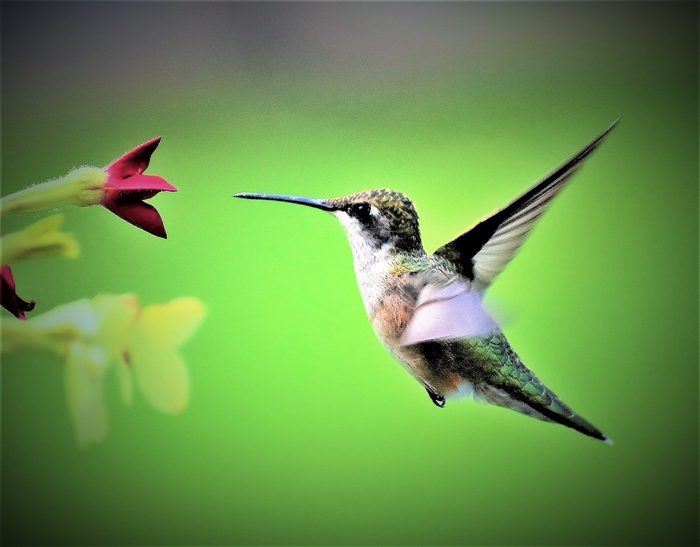
Nicotiana provides a welcome invitation for hummingbirds to the garden.
“Hummingbirds like nicotiana because the flowers are tubular and have nectar that the birds enjoy,” says Barbara. “Nicotiana is so free flowering that there are many flowers open at a time for feeding. Moths also are attracted to nicotiana; I enjoy seeing (them) in the late afternoon and evening.”
Adding nectar rich flowering tobacco plants to your healthy garden can tantalize hungry hummingbirds to join the butterflies and bumblebees at your blossoming buffet.
“Hummingbirds need a lot of energy.” says Ben Young III, urban naturalist and host of “Wild New York” on YouTube, “Their hearts beat up to 1,200 times a minute! When they’re foraging for nectar, a one-stop-shop like Nicotiana alata have blooms in bunches, meaning a hummingbird can gather quite a bit of nectar without flying too far.”
Why Trust Us
For nearly 30 years, Birds & Blooms, a Trusted Media Brand, has been inspiring readers to have a lifelong love of birding, gardening and nature. We are the #1 bird and garden magazine in North America and a trusted online resource for over 15 million outdoor enthusiasts annually. Our library of thousands of informative articles and how-tos has been written by trusted journalists and fact-checked by bird and garden experts for accuracy. In addition to our staff of experienced gardeners and bird-watchers, we hire individuals who have years of education and hands-on experience with birding, bird feeding, gardening, butterflies, bugs and more. Learn more about Birds & Blooms, our field editor program, and our submission guidelines.
Sources
- Barbara Pierson, horticulturalist and nursery manager at White Flower Farm
- Jen McGuinness, author, Bird-Friendly Gardening: Guidance and Projects for Supporting Birds in Your Landscape, available March 19, 2024
- Ben Young III, urban naturalist and host of Wild New York on YouTube
- Cornell Cooperative Extension
- New York Botanical Garden
- Missouri Botanical Garden
- All-America Selections
On This Page
Columbine Flower Care and Growing Tips

- Scientific name: Aquilegia
- Common name: Columbine or granny’s bonnet
- Zones: 3 to 8
- Light needs: Partial shade to partial sun
- Size: 2 to 3 feet tall
Columbine (Aquilegia) is the name of a genus of multi-colored flowers that bloom in the spring and are loved by gardeners for how easy they are to maintain. A columbine flower is a perennial plant, which means it comes back every year instead of dying off after a single growing season. You may also know it by its nickname, granny’s bonnet, a nod to its bell-shaped blossoms that are so heavy, they cause the stems to droop.
Hardy in Zones 3 to 8, columbine reaches 2 to 3 feet tall in good growing conditions. Identify it by its thin stems and five round-petaled blooms that are framed by sepals or spurred petals, creating a colorful, two-toned look. The foliage is a lush green with rounded or heart-shaped leaves, making it a handsome plant even after the blooms have fallen off.
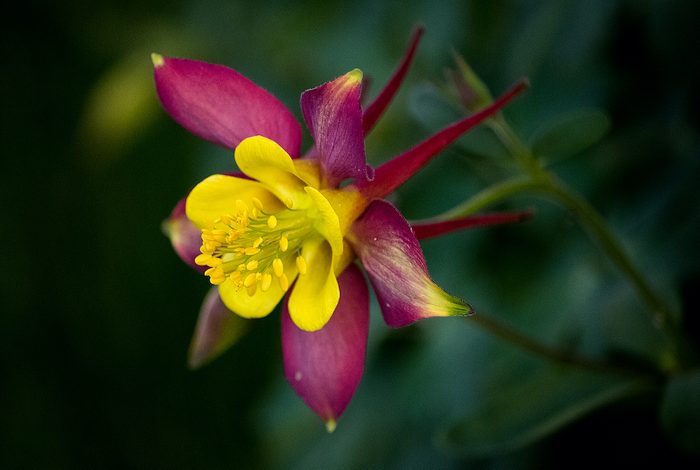
Although columbine isn’t fussy about its growing conditions, there are some things to keep in mind. It grows best in partial shade but will tolerate full sun, especially in cooler climates.
Columbine prefers well-draining soil with neutral to slightly acidic Ph levels. Most varieties are drought-tolerant, making it a good choice for rock gardens. Established plants only need watering about once a week—but make sure not to drench them. Regarding fertilizer, note that too much nitrogen puts a damper on their blooms.
Check out more of the best perennials to grow for hummingbirds.
Are Columbines Native Wildflowers?
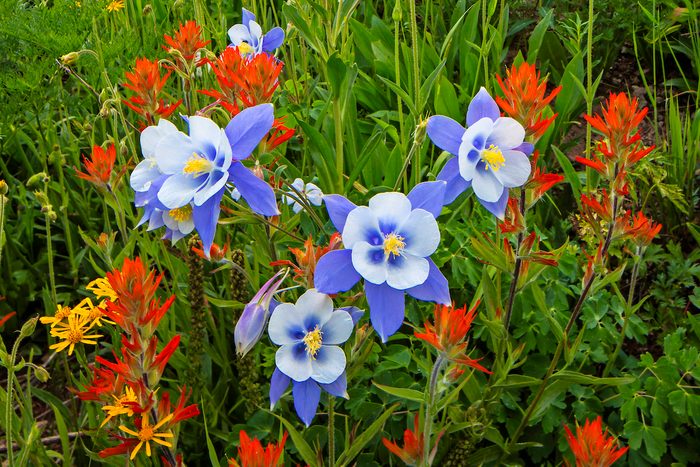
Plant enthusiasts best know columbine as a native wildflower, though of course, it can be grown in gardens and backyards— often with or without human help. Colorado’s state flower, the Colorado blue columbine, is a descendant of one of the earliest native columbines in North America. Another well-known wildflower species is Eastern red columbine, native to most states east of the Rockies.
These days, there are about 70 columbine flower species and counting. Columbine propagate and cross-pollinate easily, so it’s not unusual for new hybrids to hit garden shops every year.
A couple cultivars to try include the Kirigami series (the blooms tilt up for a bigger wow factor) and Black Barlow (the dark petals amp up the drama).
When and Where to Plant Columbine
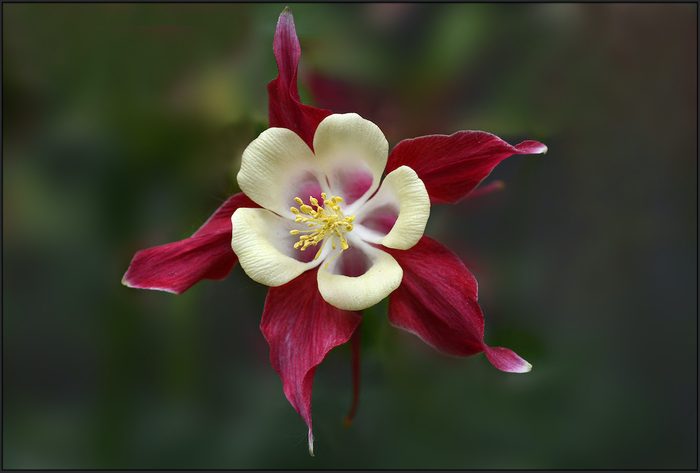
Columbine are spring blooming flowers, so one of the best times to introduce them to your garden is in autumn. No need to get the trowel out for columbine—most gardeners direct sow the seeds by simply pressing them into the soil. They need sunlight to germinate, so you don’t want to bury them. Once established, columbine readily self-seeds and produces more seedlings on its own.
You can also direct-sow seeds outdoors in early spring or start seeds indoors in mid- to late winter. Note that columbine seeds germinate best if chilled at 40 degrees for a few weeks. This cold period is known as known as stratification.
Around 30 to 90 days after planting, you’ll have seedlings that should be watered frequently to maintain moisture. Just don’t go overboard and drown them. Transplant indoor-grown seedlings to your garden after the last spring frost.
Columbine adds pops of color in-between the last spring bulbs and the first summer flowers. Deadhead spent blooms to encourage additional flowering. Gardeners like to use columbine in borders and beds but it can also be grown in containers if you’d prefer to more strictly control its spread. Many container-bound columbine are hardy enough to come back in spring.
Columbine Pests and Diseases
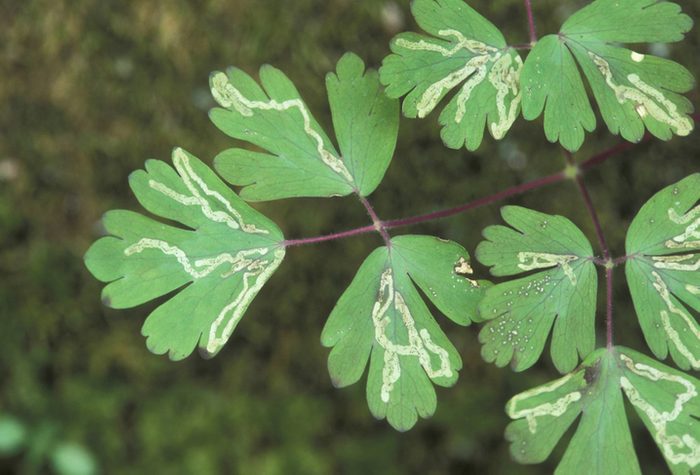
Because columbine is a native perennial, it’s a really hardy plant but it can sometimes encounter issues, too. Pests like columbine leafminer attack by damaging the foliage as they feed until maturity. The adult flies are hard to spot but if you see squiggly stripes on foliage, you probably have a leafminer problem. Their larvae overwinter in the ground, so turning up the soil may help control their population. Removing infected leaves is a good idea, too. Luckily, leafminers only affect how the plant looks and won’t destroy it.
Do Columbine Flowers Attract Hummingbirds?
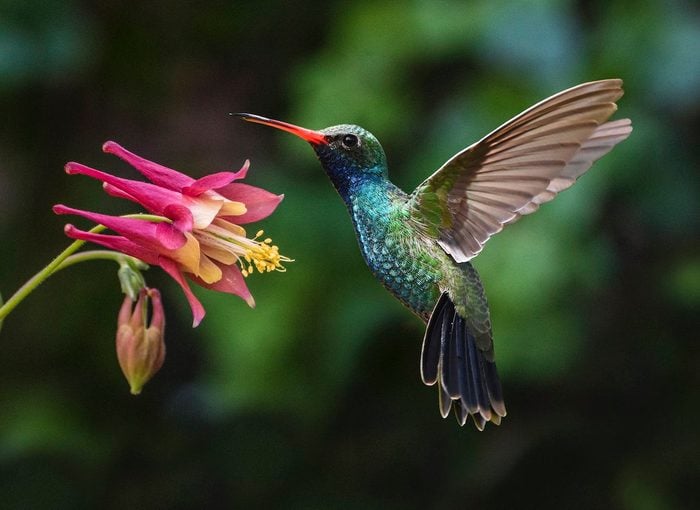
The biggest motivator for bringing columbine into your landscape is for all the hummingbirds and backyard pollinators it attracts. Hummingbirds especially love it because of the flowers’ tubular shape. Another bonus? The blooming season is perfectly timed for when hummingbirds are returning and looking for a major energy boost.
Hummingbirds will stop at any color of flower but they especially love warm hues, so red or pink columbine are your best bet for attracting them. Butterflies, moths and bumblebees love the nectar-rich blooms, too.
Why Trust Us
For nearly 30 years, Birds & Blooms, a Trusted Media Brand, has been inspiring readers to have a lifelong love of birding, gardening and nature. We are the #1 bird and garden magazine in North America and a trusted online resource for over 15 million outdoor enthusiasts annually. Our library of thousands of informative articles and how-tos has been written by trusted journalists and fact-checked by bird and garden experts for accuracy. In addition to our staff of experienced gardeners and bird-watchers, we hire individuals who have years of education and hands-on experience with birding, bird feeding, gardening, butterflies, bugs and more. Learn more about Birds & Blooms, our field editor program, and our submission guidelines.
Sources
- University of Wisconsin-Madison Division of Extension
- The Connecticut Agricultural Experiment Station
- New York Botanical Garden
- Monrovia
- Utah State University Extension
- Britannica
- United States Department of Agriculture
- Virginia Cooperative Extension
- The National Gardening Association
On This Page
Fuchsia Plant Care and Growing Tips
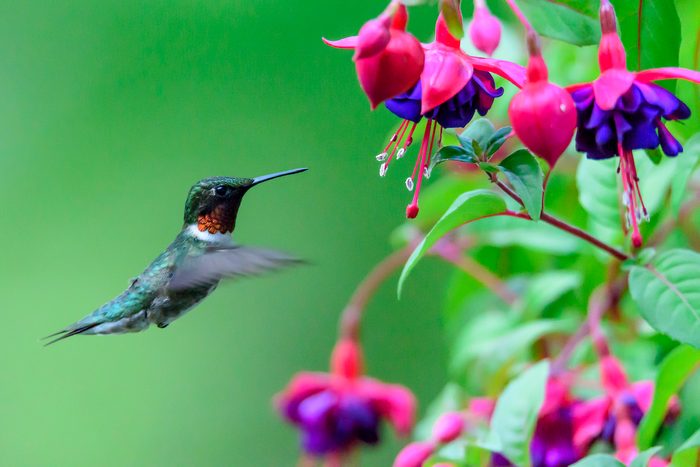
- Scientific name: Fuchsia spp.
- Common names: Fuchsia, lady’s eardrops, hardy fuchsia, hummingbird fuchsia
- Light needs: Shade to Part Shade
- Hardiness zones: 10 to 11 or annual
- Size: 10 to 24 inches tall
- Benefits: Attracts hummingbirds, birds, butterflies and moths
Fuchsias are summer flowering plants with colorful, pendulous blossoms. Hummingbirds are attracted to the flowers’ bright colors. Their long tongues have adapted to access the high amount of nectar.
Fuchsias are perennial plants in zones 10 and 11, but most are not winter hardy so you can treat them as annuals or overwinter them as houseplants. Many have a trailing habit, perfect for hanging baskets and containers. The upright forms can be trained as standards (tree or lollipop shape) or as small shrubs.
Although there are a few with variegated foliage, most plants have 2- to 4-inch long, green, oval shaped leaves. The plant blooms from summer to frost and the blossoms appear in pairs on 1- to 2-inch thin stems.
Blossoms can be narrow and tubular like trumpets or ornate like a lady’s earring. The ornate ones have reflexing sepals (the outermost part), a bell-shaped corolla (the petals), protruding long stamens, and a very long pistil. Often, the arching sepals are a different color than the bell-shaped corolla.

There is a wide range of flower colors—red, pink, purple, orange, magenta, salmon, white—and color combinations. There also are double flowered types, creating a ruffled appearance.
The plants prefer moist, well-drained soil, high in organic matter. They tolerate shade well. To encourage continuous blooms, fertilize with one that is especially formulated for blooms.
Fuchsia Plant Problems
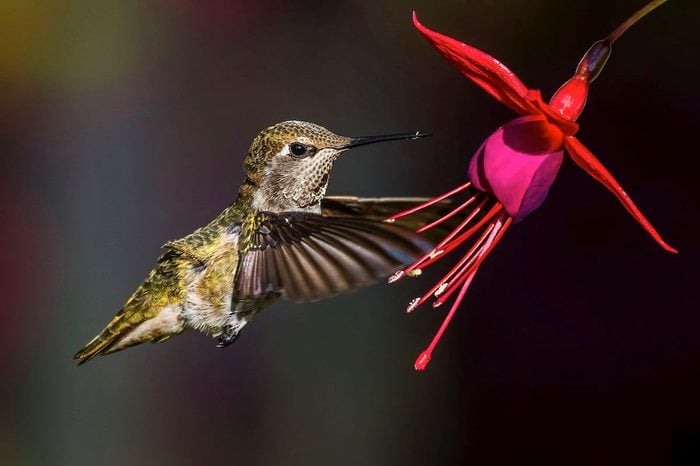
Most fuchsias are not winter hardy, but they are not heat lovers either. They thrive in cool summers with day temperatures of 60 to 70 degrees, dropping 10 degrees at night. They do very well in the Pacific Northwest but in areas with hot summers, they will stop flowering when temperatures climb above 70 degrees. It is unlikely the plants will die, but no flowers means no hummingbirds. Gardeners who live in hot areas should purchase heat tolerant varieties and place their plants in the shade.
Learn how you can help hummingbirds in extremely hot weather.
Propagating Fuchsia Plants
Fuchsias can be propagated by softwood cuttings. In early summer, take a 6-inch stem cutting, remove the lower leaves, and dip the cut end in a rooting hormone. Place in small, 4-inch plastic container with drainage holes. Moisten the potting mix and cover with a plastic bag. Place in the shade, in a warm spot. The cutting should take about a month to root.
Learn how to attract hummingbirds to a small garden.
Overwintering Fuchsia
To overwinter plants, bring them in before frost, trim down to 6 inches. and place in a cool, dark area. They will become dormant, drop their leaves, and require no water (unless completely dry). In the spring, move to a warm, bright area in the house and resume watering. After frost has past, move the plants outside and repot with fresh potting mix.
Check out the top 10 annuals that attract hummingbirds.
Recommended Fuchsia Varieties
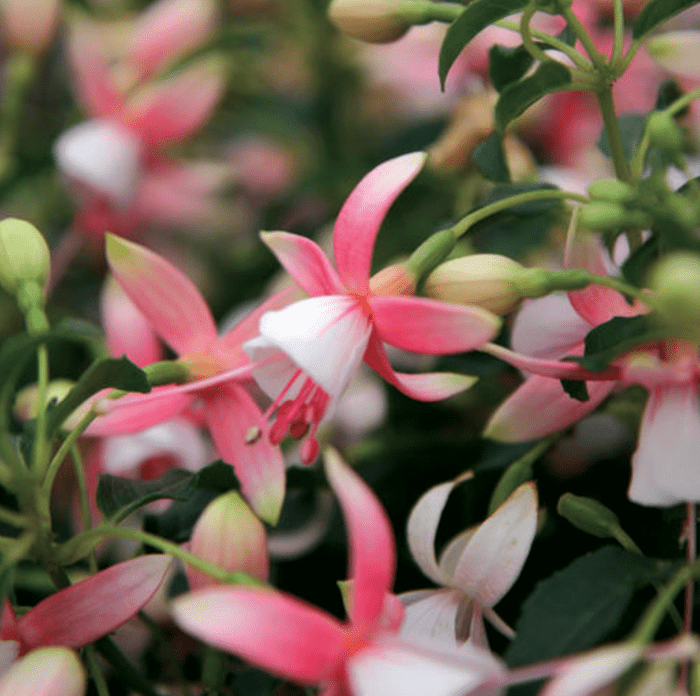
For heat tolerance, try hybrids with F. triphylla parentage such as “Billy Green” (slender tubular pink flowers) and “Gartenmeister Bonstedt” (slender tubular orange flowers with bronze-green foliage and red-purple veins). Also, check out Suntory Flowers’ Angel Earrings series, which were specifically bred for heat tolerance.
Although most fuchsias are hardy to zones 10 and 11, there is one species hardy to zones 6 and 7. Hardy fuchsia, F. magellanica, has long tubular blossoms in shades of purple and pink and can be grown as a deciduous shrub. When shopping for cold hardy fuchsias, look for hybrids with F. magellanica parentage such as “Riccartonii” (purple and red blossoms).
For variegated foliage, try “Gartenmeister Bonstedt” mentioned above, or “Firecracker” (variegated cream and green with purple veins), or “Autumnale” (yellow to coppery orange foliage).
For small containers, check out Proven Winners’ line of compact plants called Shadow Dancers: Betty, Yolanda, Rosella, and Violette. These upright plants grow to 8 to 12 inches tall.
Why Trust Us
For nearly 30 years, Birds & Blooms, a Trusted Media Brand, has been inspiring readers to have a lifelong love of birding, gardening and nature. We are the #1 bird and garden magazine in North America and a trusted online resource for over 15 million outdoor enthusiasts annually. Our library of thousands of informative articles and how-tos has been written by trusted journalists and fact-checked by bird and garden experts for accuracy. In addition to our staff of experienced gardeners and bird-watchers, we hire individuals who have years of education and hands-on experience with birding, bird feeding, gardening, butterflies, bugs and more. Learn more about Birds & Blooms, our field editor program, and our submission guidelines.
Sources
- Missouri Botanical Garden
- Clemson Cooperative Extension
- University of Washington Botanic Garden
- https://suntoryflowers.com/series/angel-earrings/
- Mendocino Coast Botanical Gardens
- Proven Winners
- PennState Extension
- Northwest Fuchsia Society
- https://www.beelife.org/do-fuchsias-attract-bees/
- https://www.hummingbirdsociety.org/hummingbird-flowers
Trumpet vine is a hummingbird magnet, but it’s not the right fit for every garden. Learn where and how to grow this pollinator favorite, and when you should avoid growing it.
Check out the top 10 red hummingbird flowers to grow.
On This Page
Trumpet Vine Care and Growing Tips
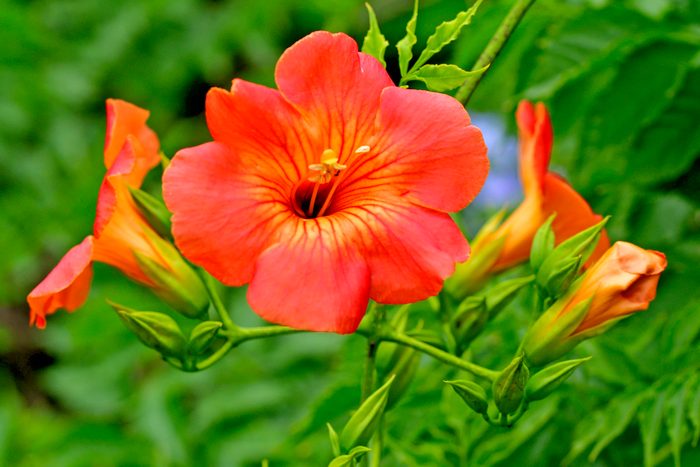
- Botanical name: Campsis radicans
- Other common names: trumpet creeper, devil’s shoestring, cow vine
- Growing zones: 4 to 9
- Size: Vining plant with stems up to 40 feet
- Light needs: Full sun to part shade
- Water needs: Medium
This fast-growing vine is quick to climb high up fences, trees, or other supports using its aerial rootlets. The shiny serrated leaves grow in leaflet pairs of three to six, and the waxy 3- to 4-inch long trumpet-shaped flowers that give it its name are red to reddish-orange. Cultivars like ‘Flava’ have yellow flowers instead. All parts of trumpet vine are mildly toxic, so wear gloves when handling and keep plants away from pets and children.
Horticultural expert Melinda Myers says, “Trumpet vines require patience. First and foremost, they need to reach maturity before they start blooming. This can take several years after planting. It’s important to avoid high nitrogen fertilizers, because they promote leaf and stem growth while also preventing flowering.”
Here are the top 10 vines to grow for hummingbirds.
Does Trumpet Vine Attract Hummingbirds?
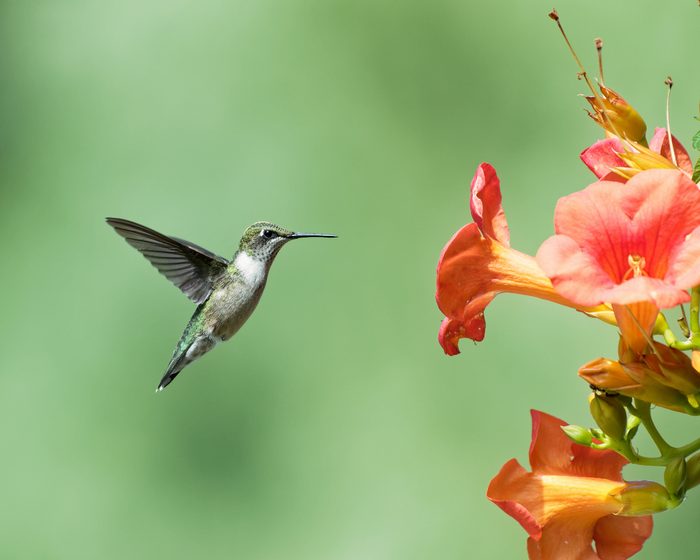
Those deep flowers hold sweet nectar at their base, drawing hummingbirds in to feast. These birds pollinate the plant, along with bees, butterflies and ants, among others. The leaves also serve as a host plant for the caterpillars of the Plebeian sphinx moth (Paratrea plebeja), too. That makes this blooming vine an all-around winner in a wildlife garden that has the space for it.
Did you know: Trumpet vine can offer hummingbirds up to 10 times more nectar than most plants.
Find more tube-shaped flowers that attract hummingbirds.
Where to Grow Trumpet Vine
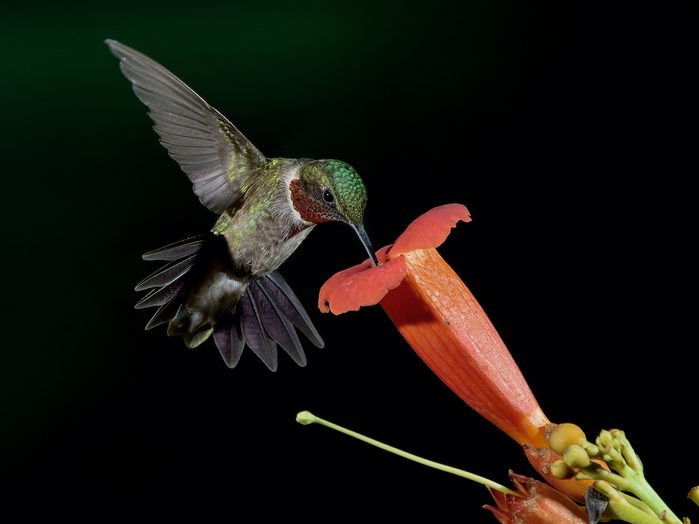
Like most vines, this one does best in a place where it can climb. At ground level, it tends to overtake everything around it, so give it a fence, trellis, or even tall tree to clamber up instead. It can also make a cool container plant, especially in hanging baskets where the trailing blooming vines really come into their own.
Trumpet creepers grow well in many soils, as long as they’re well-draining. It’s even drought-tolerant once established. Give it lots of sun to maximize flowering. Individual vines can stretch up to 40 feet long, so provide plenty of room for them to stretch and thrive.
One real advantage to this flowering vine is its deer-resistance. It rarely experiences serious pests and diseases, though powdery mildew and leaf spots can be occasional problems. Remove affected leaves as soon as you see them, and rake up leaf litter in the fall to minimize the issue the following season.
Psst—hummingbirds will also flock to a hummingbird mint plant.
Is Trumpet Vine Invasive?

This wide-ranging plant is native or naturalized across most of the United States: north to New England and south all the way to Florida, and across the central plains into Kansas and Texas. It’s been planted as an ornamental hummingbird plant in many other places across the country.
Even in its native areas, trumpet creeper can quickly become unruly in smaller gardens or landscapes, taking over a space. The aerial roots can damage wood and stone, including on buildings. It may need regular pruning to keep it in check in many landscapes. Cut it back to the ground in early spring to encourage fresh, healthy growth. Then, prune throughout the growing season as needed, wearing gloves to avoid the mildly toxic sap the vines produce.
This vine also travels by roots underground, popping up many feet away from the original planting. Rooting it out can be difficult, so take care in planting it initially. If you have concerns about whether trumpet vine is right for your landscape, consult your local county extension office or a master gardener for advice.
Melinda says, “Though a real hummingbird magnet, the suckering characteristic is a big downside of this vine. Trumpet vine sends up runners that can be challenging to manage. Continually pruning the shoots to the ground as they appear will eventually starve the plant, but you must remove every one. As you discovered, it can take a lot of time and effort. Another option is you can paint the leaves with a total vegetation killer. If you do, be careful not to touch nearby desirable plants and know that repeat applications will be needed. As always, be sure to read and follow label directions.”
Next, learn how to grow nectar-rich native plants for hummingbirds across the country.
Why Trust Us
For nearly 30 years, Birds & Blooms, a Trusted Media Brand, has been inspiring readers to have a lifelong love of birding, gardening and nature. We are the #1 bird and garden magazine in North America and a trusted online resource for over 15 million outdoor enthusiasts annually. Our library of thousands of informative articles and how-tos has been written by trusted journalists and fact-checked by bird and garden experts for accuracy. In addition to our staff of experienced gardeners and bird-watchers, we hire individuals who have years of education and hands-on experience with birding, bird feeding, gardening, butterflies, bugs and more. Learn more about Birds & Blooms, our field editor program, and our submission guidelines.
Sources:
- https://www.missouribotanicalgarden.org/PlantFinder/PlantFinderDetails.aspx?kempercode=b840
- https://www.wildflower.org/plants/result.php?id_plant=cara2
- https://plants.usda.gov/DocumentLibrary/plantguide/pdf/pg_cara2.pdf
- https://www.butterfliesandmoths.org/species/Paratraea-plebeja
- https://portal.ct.gov/CAES/Plant-Pest-Handbook/pphT/Trumpetvine-Campsis
- https://edis.ifas.ufl.edu/publication/FP099
- Birds & Blooms official gardening expert Melinda Myers
You probably recognize common feeder birds by color. Red? Cardinal. Blue? Blue jay. Yellow? Goldfinch. But when all of those colors and more are on one bird, you’re looking at a painted bunting.
Meet more beautiful bunting bird species you should know.
On This Page
What Do Male and Female Painted Buntings Look Like?
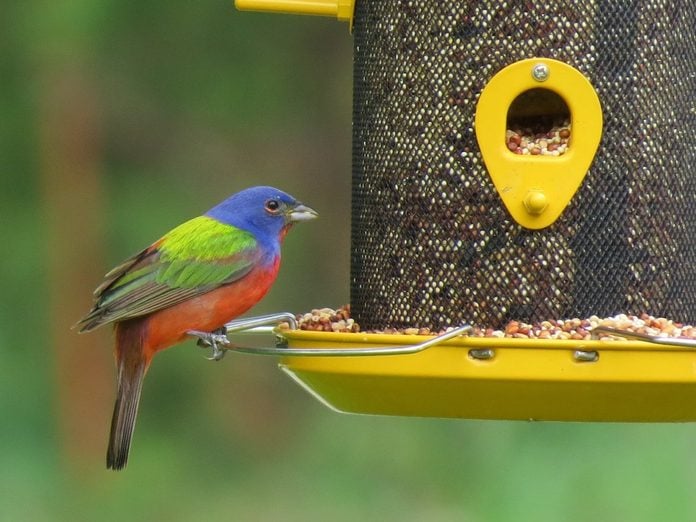
Males have bright blue heads, red bodies and yellow-green backs, with darker green on the wings. They develop this bold color in the fall of their second year.
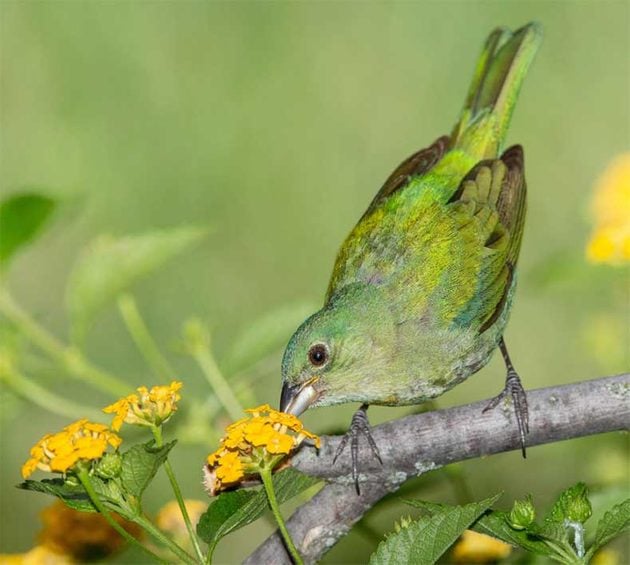
Females and juveniles sport a lime green hue, an unusual color among North American feeder birds.
Blue grosbeak vs indigo bunting: how to tell them apart.
Painted Bunting Nest
During the breeding season, males are extremely territorial. They stake out an area of about 3 to 8 acres and defend it vigorously from other males. Vicious fights may ensue, with males wounding other males. Females may even get caught up in the fray. Together the male and female choose a nest site, generally in dense vegetation about 3 to 6 feet off the ground.
Females build the nests and lay a clutch of three or four pale eggs speckled with brown, which they incubate alone for about 11 days. Once the eggs hatch, the female stays busy feeding her young brood, again with no help from her mate. The hatchlings fledge the nest in about nine days, and females often lay a second clutch of eggs soon after.
Learn how to identify a varied bunting.
Painted Bunting Song
Once the territory is secure, males sing and spread their feathers to attract a mate. Only male painted buntings sing songs like: graffiti graffiti spaghetti-for-two. If you think you see a plain green female bursting into song, it’s most likely an immature male in his first year.
Bird songs courtesy of the Cornell Lab of Ornithology
What Do Painted Buntings Eat?
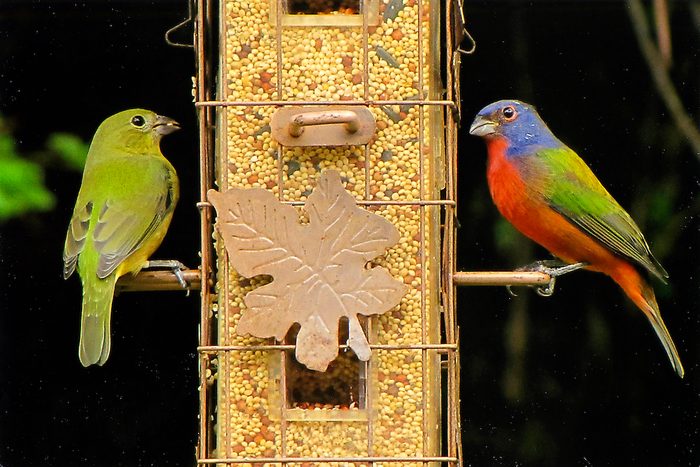
“Indigo buntings love the black oil sunflower seeds I put out. But their more colorful relative, painted buntings, do not. How can I attract them?” asks reader Kara Minter Petal, Mississippi.
Birding experts Kenn and Kimberly Kaufman say, “In terms of food, painted buntings are seedeaters. For those fortunate enough to have them on their list of yard birds, white millet seems to be the seed of choice. Birdbaths with moving water—a dripper or mister, for example— can also help entice these multicolored marvels to your yard.”
Painted buntings are wary and easily scared off, so hang a feeder with a protective cage around the tube to discourage larger bully birds.
During the breeding season, they switch to protein-heavy insects for extra energy. Females may steal bugs caught in spiderwebs, and even pull webs down to feast on the spiders that built them.
Once breeding season ends, they return to seeds, especially ones they find on or near the ground.
How to Attract Painted Buntings
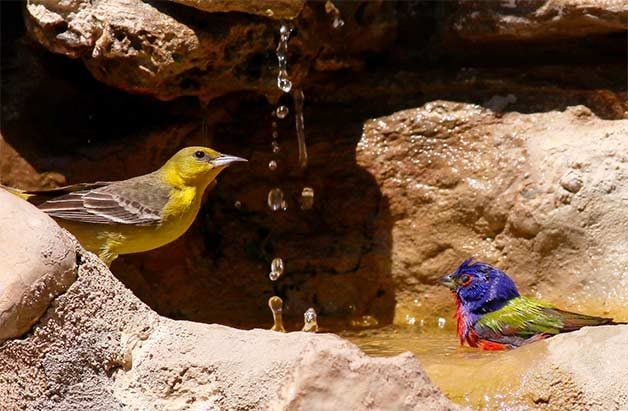
Kenn and Kimberly say, “You’d think a bird that looks like a feathered rainbow would want to be seen, right? But painted buntings can be shy and difficult to attract to backyards. For starters, they prefer habitat with a lot of cover, so areas with low, dense shrubbery are more appealing.”
Ensure that your yard provides the right habitat by planting plenty of native shrubs and grasses. Painted buntings nest close to the ground in low-growing vegetation, so having these on your property raise your chances of bringing in a breeding pair.
Painted buntings also like to have an easy source of water to visit.
Patience is the key with painted buntings. They may be slow to come around, but once they find a constant food source, water and protective shelter, they’re likely to return frequently.
Learn what snow buntings look like and where to find them.
Painted Bunting Range and Migration
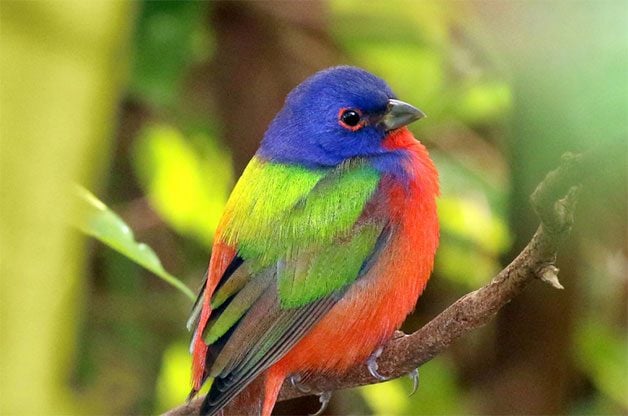
Look for painted buntings in the south central and southeastern states. They have two distinct summer breeding areas. One covers a large area from Texas to Mississippi and north to Kansas, and another is centered in the coastal Carolinas.
Painted buntings undertake a short winter migration to Florida, Mexico and Central America, when they gather in small mixed flocks with other birds, such as their indigo bunting cousins.
Editor’s note: Look for painted buntings in Florida. It’s the only state that consistently has a spring and summer breeding population and a winter population.
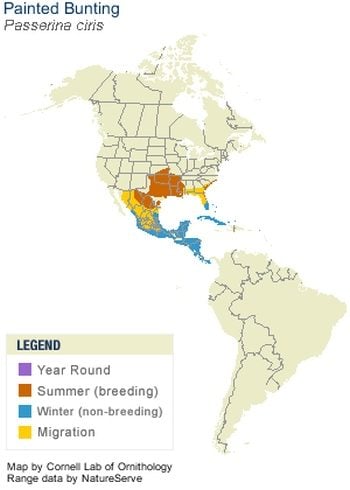
Next, learn about lazuli buntings: vibrant jewels of the west.
Why Trust Us
For nearly 30 years, Birds & Blooms, a Trusted Media Brand, has been inspiring readers to have a lifelong love of birding, gardening and nature. We are the #1 bird and garden magazine in North America and a trusted online resource for over 15 million outdoor enthusiasts annually. Our library of thousands of informative articles and how-tos has been written by trusted journalists and fact-checked by bird and garden experts for accuracy. In addition to our staff of experienced gardeners and bird-watchers, we hire individuals who have years of education and hands-on experience with birding, bird feeding, gardening, butterflies, bugs and more. Learn more about Birds & Blooms, our field editor program, and our submission guidelines.
Sources
- Kenn and Kimberly Kaufman, official birding experts for Birds & Blooms
- The Cornell Lab of Ornithology
On This Page
Questions About Feeding Hummingbirds
Hummingbirds are amazing creatures, with the ability to fly backward using wings that beat about 30 times a second. It’s no wonder people love attracting hummingbirds to their yards to enjoy them up close. Birding experts Kenn and Kimberly Kaufman answer some of your most frequently asked questions about feeding hummingbirds.
What’s the Recipe for Sugar Water to Feed Hummingbirds?
Mix four parts hot water to one part sugar. While some people don’t boil their water, it’s best to boil and then let it cool to room temperature to remove any impurities. Be sure to change out the sugar water every few days. You can store extra sugar water in your refrigerator for a week or more.
Should I Add Red Food Coloring to the Mixture?
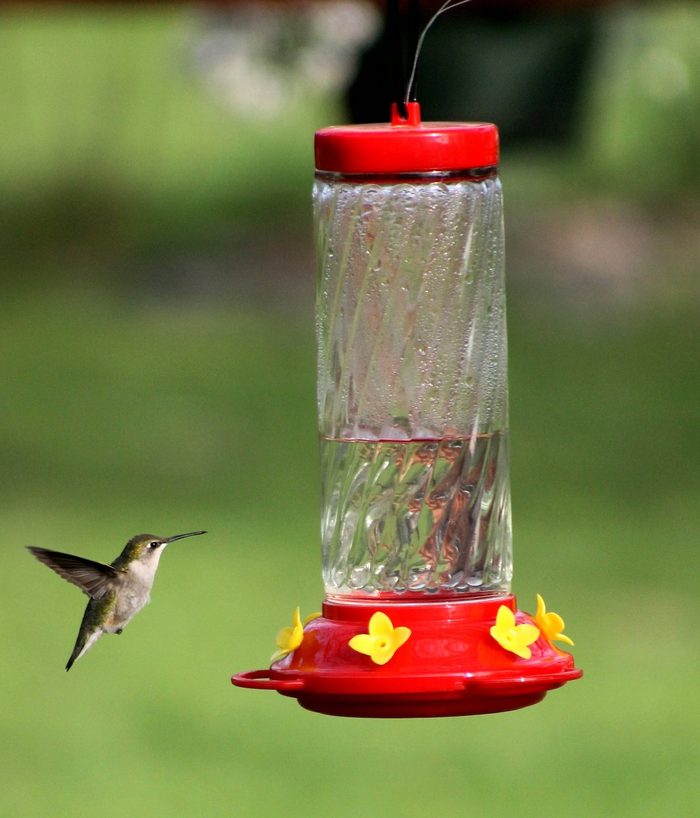
One of the older red food colorings was found to be toxic to birds, but with the new formulations, I don’t believe that’s still true. However, it isn’t necessary to add red dye or other ingredients to feed hummingbirds. The feeders usually have red parts, which provide enough color to attract hummingbirds. Stick to clear sugar water when feeding hummingbirds. You should steer clear of brown sugar, powdered sugar, honey and any other ingredient but plain white sugar.
Check out the best red hummingbird flowers to grow.
Is Organic Sugar Better for Hummingbird Feeders?
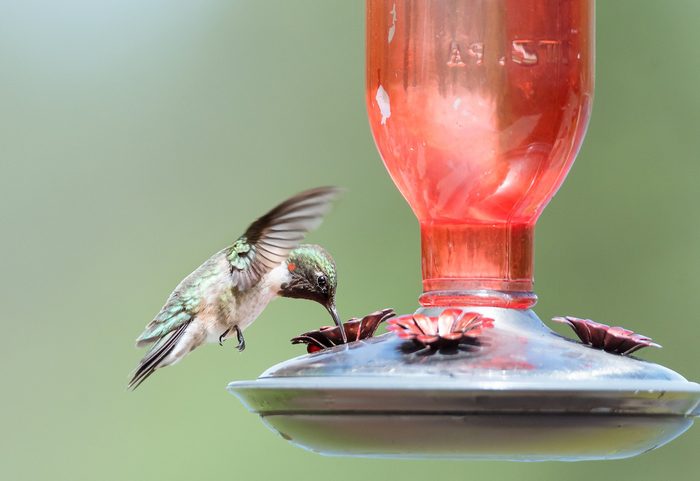
Pure white table sugar is the safest option for mixing nectar for hummingbirds. Many consider organic sugar, which doesn’t tend to be fully refined to pure sucrose, unsafe for feeding birds.
How Can I Prevent Mold Growth in Hummingbird Feeders?
“How do you keep homemade hummingbird nectar from getting moldy?” writes Birds & Blooms reader Della Lansdell of Prattville, Alabama.
We suggest mixing your own hummingbird sugar water, using 4 parts water to 1 part sugar, and bringing it to a full boil to break down the sugar completely. Once it’s cool, refrigerate what you don’t use between fillings. Avoid using red dye; the birds don’t need it, and it’s easier to monitor the freshness of colorless sugar water. Another way to avoid mold is to fill feeders only halfway and clean them before each refill. Placing your feeders in the shade will also help keep sugar water from spoiling too quickly.
What Are the Best Feeders for Hummingbirds?
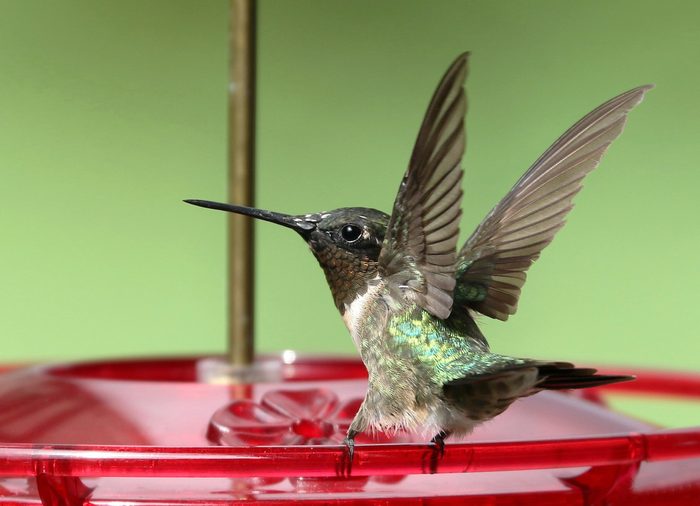
For the most part, hummingbirds aren’t picky, so the best feeder is the one you find easiest to fill, clean and hang. The traditional glass bottle that threads into a plastic basin works extremely well. We prefer the 30-ounce bottle because it’s more stable and doesn’t tip as easily when orioles drink from it. We also like the type with a shallow plastic basin where the lid with feeding ports snaps down over it. Both are easy to clean, and that is important.
Learn how to clean hummingbird feeders.
When Should I Hang My Hummingbird Feeders?
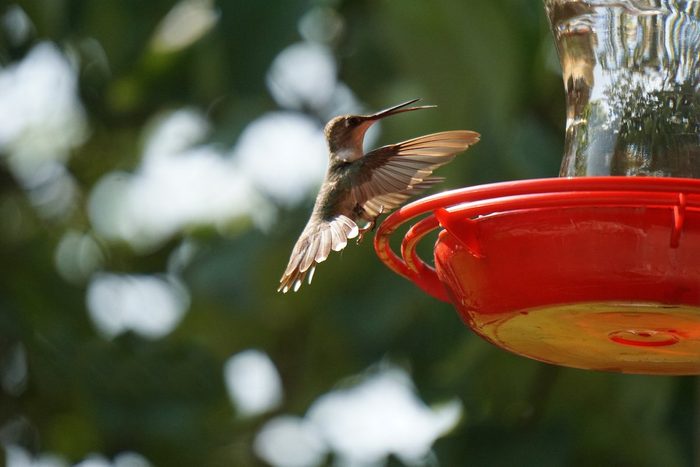
Early May is a good time to hang up your hummingbird feeders. In the South, migratory hummingbirds begin tapping sugar water feeders in backyards in early April. The funny thing about it is that if you don’t get them up early enough, the hummingbirds will often remind you by returning to the spot where the feeders were last summer and hover there looking for them.
Where Should I Hang Hummingbird Feeders?
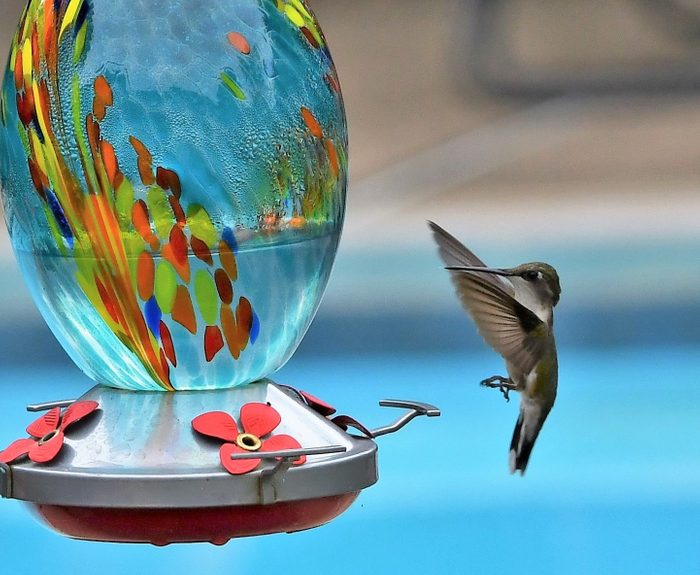
Since they’re accustomed to hovering low in front of flowers, there’s no real height requirement for hummingbird feeders. Just make sure the feeder is in a place where it’s easy to see and enjoy! This will allow you to monitor it closely for filling and cleaning, too.
Are Hummingbirds Territorial at Feeders?
“I never get more than one hummingbird at a time at my feeders. How can I encourage them to share?” asks reader Cheryl Vandermark of Wallkill, New York.
Hummingbirds have an instinct to protect their food sources, because in nature, a patch of flowers will produce only so much nectar in a day. The tiny birds carry this defensiveness over to artificial feeders. The best way to keep one hummingbird from dominating a feeder is to put up several feeders in different spots. If some feeders can be out of sight from the others (around a corner, for example), it will be even harder for one bird to control them all. With multiple feeders available, even the most aggressive hummingbirds may give up and just share with others.
Do fighting hummingbirds ever hurt each other?
I’ve Planted a Hummingbird Garden, but Why Don’t They Visit?
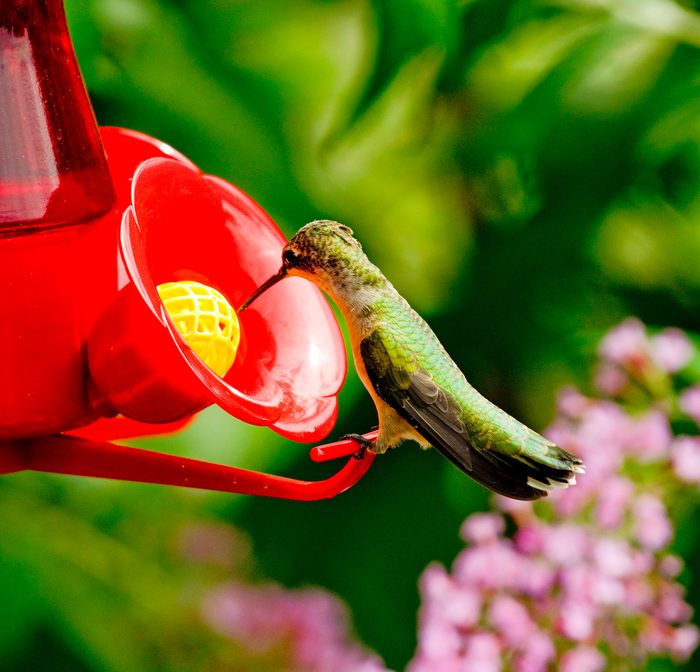
Try placing a hummingbird nectar feeder close to or among the colorful hummingbird flowers in your garden. This should create a target area for the birds and make attracting hummingbirds to your garden much easier.
Is It Better to Plant Flowers for Feeding Hummingbirds?
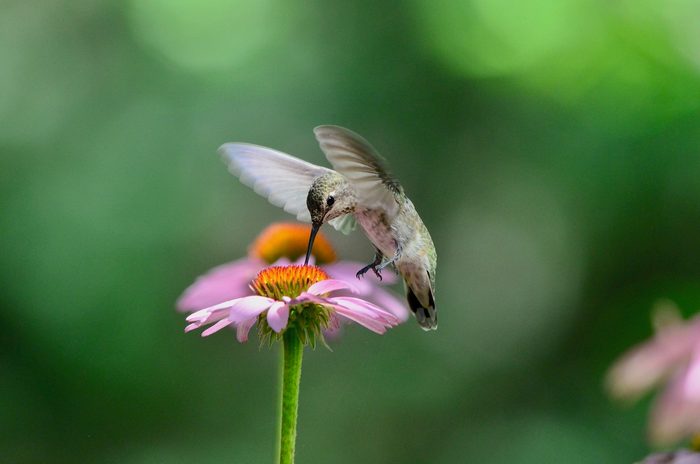
If we had to choose one over the other, we’d vote for planting flowers because they have many other benefits. A flower garden with a focus on native plants, full of a variety of species chosen to bloom throughout the warmer months, will sustain butterflies, bees and other pollinators. The tiny insects feeding on the plants’ leaves will in turn feed warblers and other songbirds.
But we think it’s ideal to have both flowers and feeders. A sugar-water feeder can be placed where it’s easy to watch, and it can help keep hummingbirds faithful to the yard during lulls in the garden’s blooming activity.
Learn how to attract hummingbirds to your small garden.
Will Hummingbirds Become Dependent on Feeders?
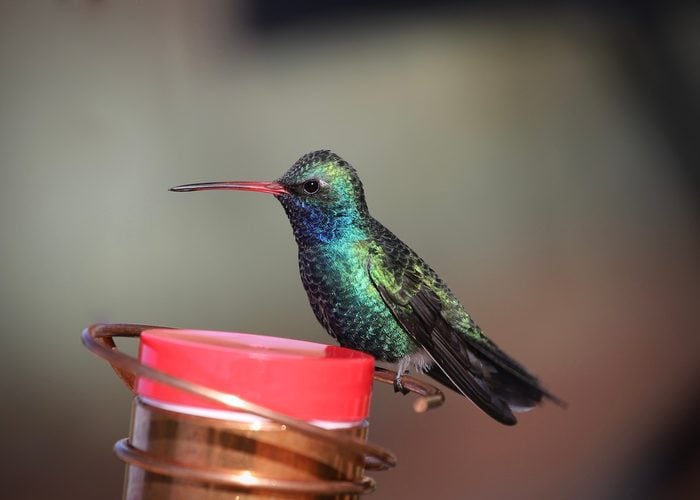
“We’re selling our house, and I’m concerned the new owners will not keep the hummingbird feeders filled. What will happen?” says reader Vincent Staley of Fredericksburg, Virginia.
We appreciate your concern, but hummingbirds are adaptable and good at finding new places to live. In natural habitats, good concentrations of flowers may change over time. For example, a meadow filled with flowers one year may be overgrown with shrubs the next. Hummingbirds have to be able to move around and find new food sources. Of course, if you can talk to the new residents of your home, you could try to inspire them with stories about feeding hummingbirds and tell them the rewards of keeping the feeders filled and clean.
Here’s how to create an ideal hummingbird habitat.
How Can I Keep Yellow Jackets Off Hummingbird Feeders?
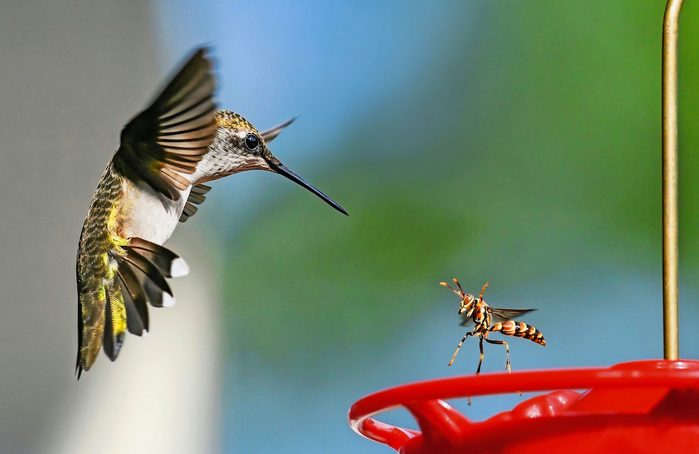
“How can I keep yellow jackets away from my hummingbird feeders? asks reader Gail Mitchell of Martinsville, Virginia.
Reducing the ratio of sugar to water might help. Try 5 parts water to 1 part sugar, instead of the usual 4 to 1. Be sure to clean any spillage off the feeding ports. Since bees and wasps prefer to feed in sunny areas, you could try moving your feeders to a shadier area. Avoid using products such as pesticides, petroleum jelly or cooking oil on the feeding ports to discourage bees and wasps, since these substances can be deadly for hummingbirds. It’s also good to remember that these insects are important pollinators, and we should protect them, too.
Check out more natural ways to keep wasps away from hummingbird feeders.
Do Bees Make Hummingbird Feeders Dirtier?
“I have several sugar-water hummingbird feeders. Bees invade some of them. When I bring in the feeders for cleaning and refilling, the ones used by bees are usually dirtier. Why?” asks reader Ellen Gonzales of Dripping Springs, Texas.
It’s hard for us to be sure without actually seeing the feeders involved, but we have some ideas. Bees only visit feeders where the sugar water is easy to reach—especially if it’s leaking or spilled on the outside. Even a very slow leak can make the feeders dirtier inside and out. Bees often carry pollen, and they may leave a light dusting of it on every visit to the feeder, adding to the mess. Check your feeders carefully for leaks, install bee guards on the openings, and consider switching to the dish feeder style in which the openings are raised well above the level of the sugar water.
Use an ant moat to keep ants off of your hummingbird feeders.
How Do Hummingbirds Feed Their Babies?
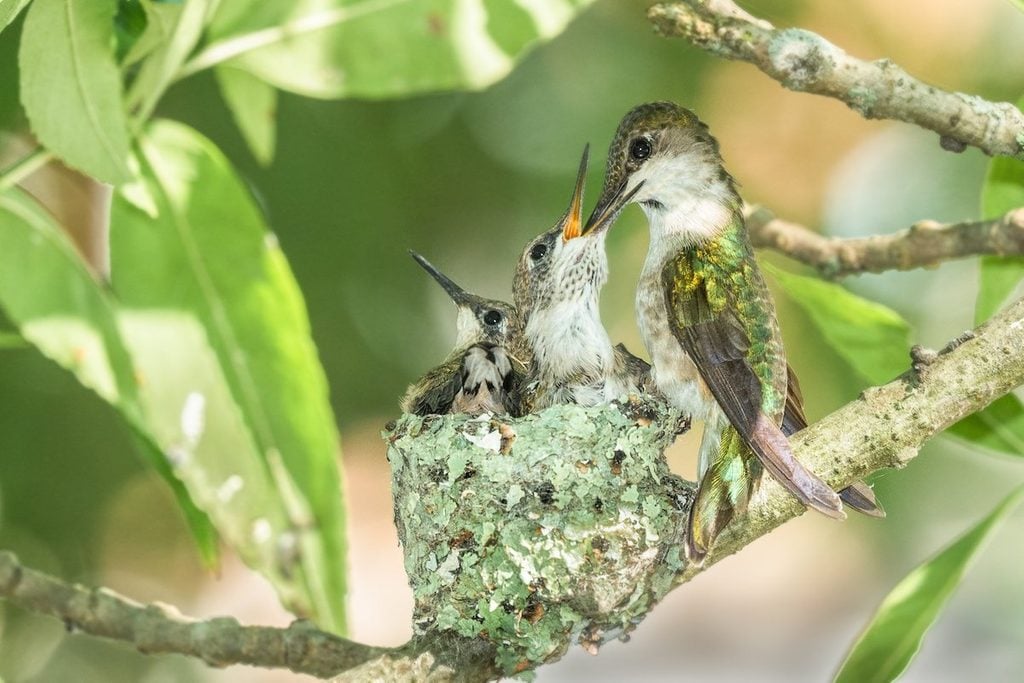
Hummingbirds usually feed tiny insects and spiders to their young. They insert them right into the mouths of their baby hummingbirds. They’ll also feed nectar and pollen to the young birds. They do this by holding it in their throats and then squirting it into the mouth of the nestlings. Sometimes this will cause the youngster’s throat to swell temporarily, resembling a goiter.
Here’s everything you need to know about hummingbird nests.
How Do Hummingbirds Drink Nectar?
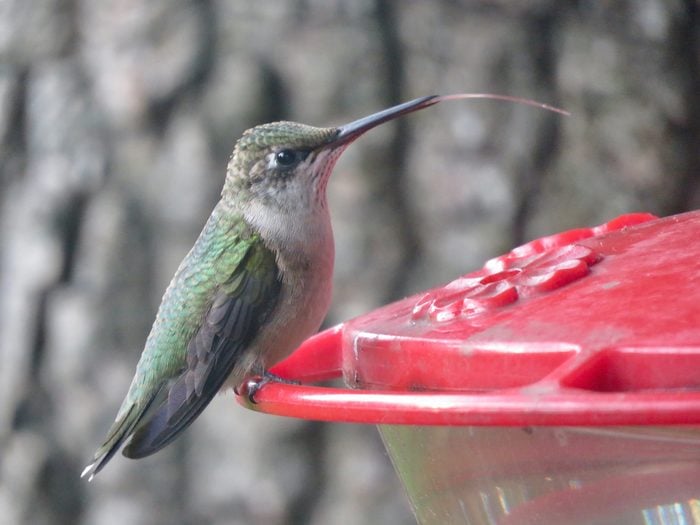
This is a bit of a tricky one. Hummingbirds seem to use their tongues in a way that scientists never expected —a hummingbird tongue’s tubes open down their sides when they insert it into a flower or feeder. When they pull the tongue back in, the tubes zip closed around the nectar, bringing it back into the bird’s mouth. They are one of the few species of birds that swallow liquid without throwing their head back to allow gravity to help them swallow.
Hummingbird sounds: do hummingbirds sing?
I Saw a Yellowish Hummingbird at My Feeder. Is This Common?
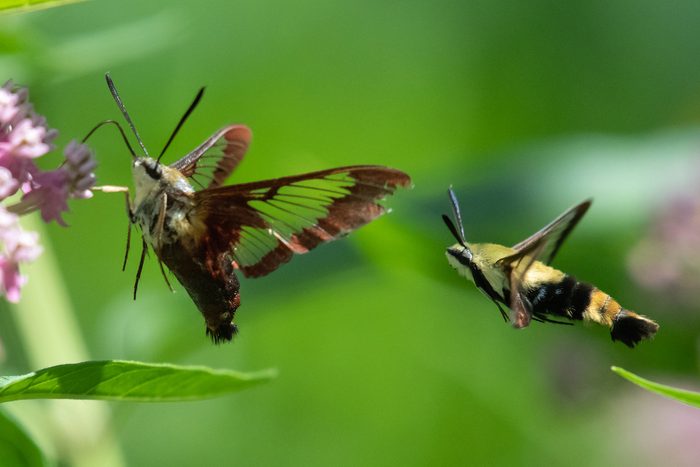
Though rare, some bird species will produce a yellow version of themselves, such as yellow cardinals. This condition is called xanthochroism, an abnormal yellowing of the plumage. It is thought to be caused by a loss of dark pigment (melanin) in the bird’s feathers. If the mystery visitor was much smaller than a hummingbird, it could be a sphinx moth, also called a hummingbird moth. This is a diurnal moth (meaning it’s out during daylight), and one variety is yellow in color and common in gardens in the summer.
What makes hummingbird feathers so shimmery?
Why Do Hummingbirds Hang Upside-Down From Feeders?
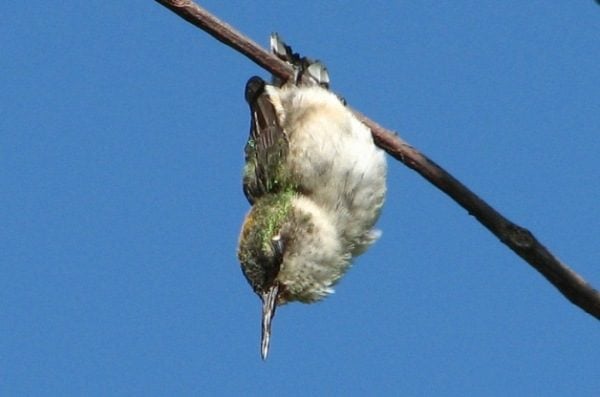
“I saw a hummingbird hanging upside down from my sugar-water feeder by one foot. As I neared, it flew away. What happened to it?” says reader Margaret Hocker of Metropolis, Illinois.
Hummingbirds have a bizarre way of conserving energy. Usually at night, during periods of cold and sometimes when they’re perched at a feeder, hummingbirds can enter a deep, sleep-like state known as torpor, when all body functions slow dramatically. Metabolism slows by as much as 95%, and heart rate and body temperature drop significantly. Torpor allows them to conserve precious energy and survive surprisingly low temperatures. Hummingbirds are tough birds! If you see a hummingbird in such a state, there is no cause for concern.
Where do hummingbirds sleep at night?
Why Do I Never See Male Hummingbirds at My Feeders?
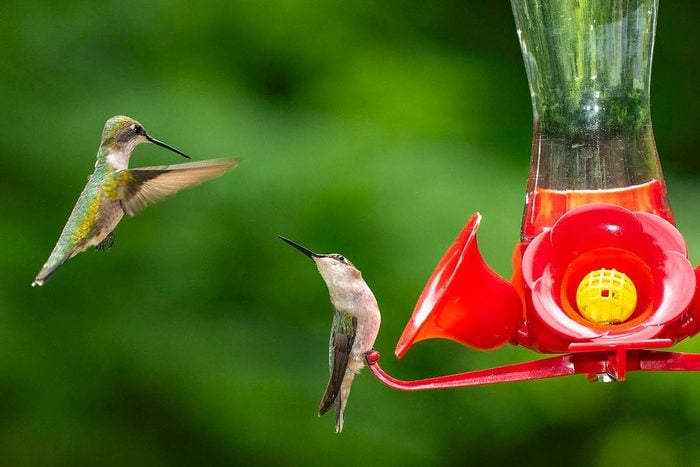
“I only have female ruby-throated hummingbirds visiting my sugar-water feeder and the flowers on my deck rail. I never see males. Do they like different flowers and the types of feeders than the females? asks reader Linda Anderson of Berwick, Pennsylvania.
Males and females generally like the same things, so there may be other factors at work here. It’s possible that the male hummingbirds in your area have territories away from your feeders and flowers so you don’t see them as often. We’ve also seen females defending the territory around the nest, actively chasing off the males and other females that venture too close. Also, remember that juvenile hummingbirds (both males and females) look like the adult females, so they outnumber the flashy ruby-throated adult males.
How Can I Help Hummingbirds Fuel Up for Migration?
Hummingbirds store enough fat to allow them to cross the Gulf of Mexico. In fact, they begin this storage before they even leave their nesting grounds. You may notice that in late summer, just before they begin to migrate south, hummingbird behavior changes a bit and they eat more food more often. They stop to feed along the way, too, and store as much energy as possible. That’s why it’s important to maintain sugar water feeders at least through September, even after hummingbird activity subsides.
Add a bird bath for hummingbirds to your yard.
Why Do Finches Visit Hummingbird Feeders?
“Is it normal for house finches to drink sugar water?” writes reader Shannan Shade of Marshall, Wisconsin.
Although hummingbirds are the only true nectar specialists in North America, many birds sample the sweet stuff when they get the chance. Once they learn to drink from hummingbird feeders, house finches may become regular visitors. Other examples of surprising visitors include titmice, several warblers (including Cape May, pine and orange-crowned), goldfinches, mockingbirds, chickadees, and thrashers. Aside from birds, your sugar water feeders also may attract nectar-feeding bats (in the Southwest), squirrels, and even bears if there happen to be any in your neighborhood.
Is that a woodpecker at a hummingbird feeder?
How Can I Keep Orioles Away from Hummingbird Feeders?
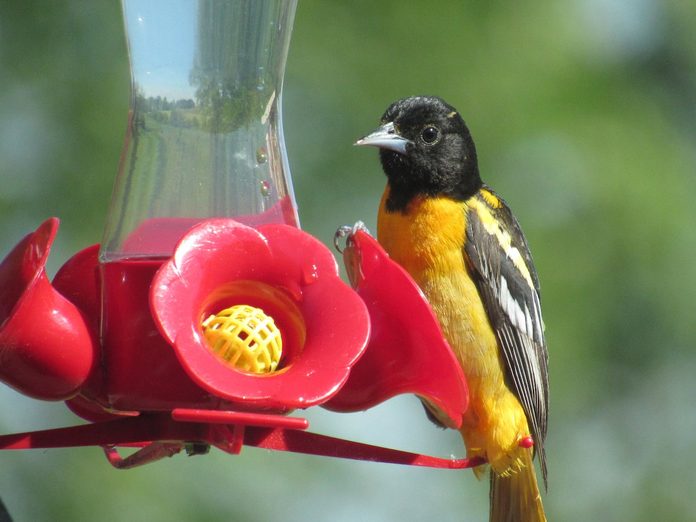
“How can I keep larger birds like orioles from monopolizing my hummingbird feeders?” says Roger Hatfield of Del Rio, Texas.
In your region of Texas, you’re lucky to have several types of orioles, but we understand why you’d want to keep space open for feeding hummingbirds. One approach is to have one or two “sacrificial” feeders, with perches that make it easy for orioles and other larger birds to drink sugar water. If you have other feeders with no perches, the hummingbirds can still hover at those to feed, ideally undisturbed by the larger birds.
Contributing writer and birding expert: George Harrison
Why Trust Us
For nearly 30 years, Birds & Blooms, a Trusted Media Brand, has been inspiring readers to have a lifelong love of birding, gardening and nature. We are the #1 bird and garden magazine in North America and a trusted online resource for over 15 million outdoor enthusiasts annually. Our library of thousands of informative articles and how-tos has been written by trusted journalists and fact-checked by bird and garden experts for accuracy. In addition to our staff of experienced gardeners and bird-watchers, we hire individuals who have years of education and hands-on experience with birding, bird feeding, gardening, butterflies, bugs and more. Learn more about Birds & Blooms, our field editor program, and our submission guidelines.
On This Page
Why You Should Make Plant Cuttings

Growing plants from cuttings is a great way to expand—or share—the beauty of any garden. Perhaps you’d like to preserve a flower with family history, increase your collection of favorite blooms or reproduce that hard-to-find plant. Most gardeners have had success rooting leafy plants like coleus or philodendron. A short stem with leaves will quickly form roots in water, potting mix or vermiculite—and then you are well on your way to a full-sized plant.
The same does not hold true for trees and shrubs, however. With these woody plants, you’ll need to pay more attention to timing and the type of cutting you take. And these factors will vary depending on the type of plant. But with a little practice, you’ll soon know how to root cuttings of woody plants like roses, lilacs, forsythias and spireas. The extra effort will be worth it.
Check out the top 10 plants to grow from plant cuttings.
Types of Rooted Woody Plant Cuttings

There are several types of rooted plant cuttings you can use to propagate new trees and shrubs. Learn more about plant propagation to multiply your plants for free.
Hardwood plant cuttings
These are the key to starting plants like roses, forsythia, privet, olive, wisteria, spirea, hemlock and many other deciduous and needled trees and shrubs.
During the dormant season, which is late fall or winter, remove a 4- to 8-inch stem piece of the previous season’s growth that contains two nodes—the place where leaves attach. Pack the cuttings in peat moss or sawdust and store them in a cool dark place until spring. As the weather warms, stick the cuttings—with the end that was closest to the roots down-in a flat of moist vermiculite, perlite or sand. To increase the success for these types of cuttings, or any others, dip the end in rooting hormone first.
Semi-hardwood plant cuttings
Summer is the time to take semi-hardwood cuttings—the new growth that’s starting to harden up and mature. This works for varieties like holly, azaleas, pittosporum, euonymus, citrus, olive and other broadleaf evergreens and deciduous trees and shrubs.
Take 3- to 6-inch cuttings in the morning when the stems are firm and full of moisture. Remove the lower leaves and cut the remaining leaves in half to reduce moisture loss.
Then root semi-hardwood cuttings in moist vermiculite, perlite or sand in a shaded and humid location. Loosely cover the container with plastic to increase the humidity and monitor the temperature to prevent overheating.
Softwood cuttings
Softwood cuttings from tender new growth are another way to propagate plants like lilacs, roses, forsythias, magnolias, weigela, spireas and fruit trees.
Take 3- to 5-inch cuttings early in the day and plant them right away for the best results. Root in a warm and moist rooting medium in a humid location that’s out of direct sun.
Expert Tips for Making and Rooting Plant Cuttings

- It’s best to take cuttings from recently watered plants. The cuttings will be healthier when taken from plants that are full of moisture.
- Make sure you have a clean, sharp knife or a good pair of pruning shears handy to make the cuts.
- Take cuttings only from healthy plants. Make sure the parent plants are disease- and pest-free. Early morning is the best time to take cuttings.
- Not all plant cuttings will root at the same speed, so if one plant takes 10 days and another takes 20 days, don’t be alarmed.
- Be prepared for this process to fail from time to time. And don’t be afraid to experiment with other plants, just to see what happens.
No matter what kind of cuttings you’re using, once they’ve rooted, you can treat them like bare-root plants and add them to your garden. Or, move them to a large container filled with well-draining potting mix. This allows the plants to develop stronger root systems before transplanting.
Learn how to propagate succulents.
Pay Attention to Patents
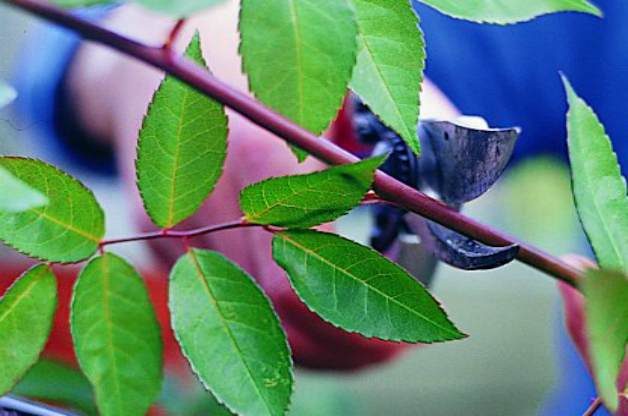
Before you take a cutting of that fancy new rose or lilac, it’s important to understand some of the laws related to the plant world.
Many new varieties are patented. This means you cannot take a cutting from an existing plant to start a new one without the permission of the patent owner. This right is reserved for the company that spent time and money developing the new or unusual variety. If this is the case, a close look at the tag or growing information will reveal a patent number or note that the patent is pending.
Patents are good for about 20 years. After that, you are free to take cuttings and start your own plants. Although it may seem like an inconvenience, remember that respecting the patents helps support those who work to introduce new plants for us to enjoy.
When checking the tag, you also may see ® or copyright symbols. You can take cuttings and plant these varieties in your garden, as long as they are not patented.
If all this sounds too confusing, don’t be intimidated. There are plenty of old family favorites and traditional garden beauties that aren’t protected—and these make great candidates to grow from cuttings.
As you begin trying to grow trees and shrubs from cuttings, I do have some last words of wisdom: Professionals often spend years perfecting this process, so don’t be disappointed if your cuttings don’t root right away. Just keep trying, and soon you should have new plants to show off for your efforts.
Next, get expert tips on how and when to prune lilacs.
Why Trust Us
For nearly 30 years, Birds & Blooms, a Trusted Media Brand, has been inspiring readers to have a lifelong love of birding, gardening and nature. We are the #1 bird and garden magazine in North America and a trusted online resource for over 15 million outdoor enthusiasts annually. Our library of thousands of informative articles and how-tos has been written by trusted journalists and fact-checked by bird and garden experts for accuracy. In addition to our staff of experienced gardeners and bird-watchers, we hire individuals who have years of education and hands-on experience with birding, bird feeding, gardening, butterflies, bugs and more. Learn more about Birds & Blooms, our field editor program, and our submission guidelines.